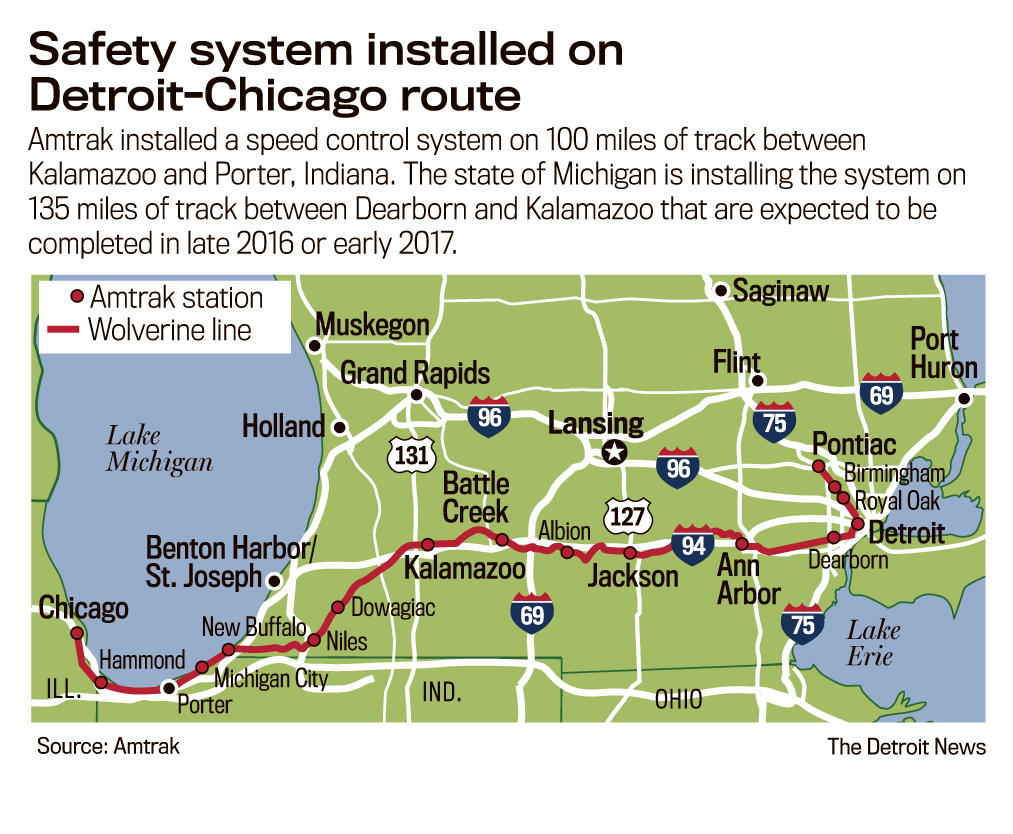From The Detroit News:
Amtrak and the state expect to have a speed control safety system along 283 miles of tracks in a year and a half as part of their effort to get faster passenger trips averaging a little more than four hours between Detroit and Chicago.
Michigan Department of Transportation rail chief Tim Hoeffner said the so-called positive train control system, part of more than $400 million in upgrades on the Wolverine Route, will protect against tragedies like the May 12 Philadelphia crash that killed eight people and injured 200.
“The engineer gets a target … when he will have to start lowering the speed,” Hoeffner said. “If you do not do that, the system says ‘we are watching’ and will take action to shut down the train.”
Amtrak installed the system on 100 miles of track it upgraded more than two years ago between Kalamazoo and Porter, Indiana. The state will have it on 135 miles of track between Dearborn and Kalamazoo that are undergoing upgrades to be completed in late 2016 or early 2017, Hoeffner said.
Automated train controls are federally required for higher-speed passenger rail by the end of the year, but hadn’t been installed on the section of track where the Philadelphia derailment occurred. Federal regulators say few rail operators will meet the deadline, according to press reports.
Hoeffner said the Michigan Department of Transportation, Amtrak and the Federal Railroad Administration began collaborating in the 1990s on a positive train control system for the Wolverine Route. The route carries more than 500,000 passengers a year.
Called Intermittent Train Control System, Michigan’s version of the technology first was installed between Kalamazoo and Porter, Indiana. Trains have hit speeds up to 110 miles an hour there since February 2013, Hoeffner said.
Contractors now are installing the system with track upgrades between Dearborn and Kalamazoo. Michigan is using $387 million in federal grants and $37.5 million of its own money to buy and improve the tracks for 110-mile-an-hour train speeds, according to Hoeffner.
“Our intention is to have higher speeds all the way across Michigan,” said Amtrak spokesman Marc Magliari in Chicago. The route has the most miles of 110 mph Amtrak rail outside the Northeastern corridor, Magliari said.
Hoeffner said the train control setup combines modern technology with traditional signal lights spaced at intervals along the track, which have told engineers since the early 1900s to slow, stop or remain at regular speed.
Engineers now also receive the same directions from an on-board display. If they fail to respond, the system can halt the train, after which the engineers need clearance from the railroad’s control center to restart, Hoeffner said.
The goal of MDOT and Amtrak is to run trains safely at higher speeds to lop more than an hour off Detroit-Chicago trips, making them competitive with auto travel, Magliari said.
“A lot of days of the week we’re already faster than driving, considering traffic congestion in Chicago and Detroit,” he said.
But there’s one remaining obstacle to reliably faster service: Passenger trains run at lower speeds and often get stalled — sometimes more than an hour — waiting for traffic to clear from the busy rail corridor between Porter, Indiana and Chicago’s Union Station.
It’s one of the nation’s most congested rail corridors, handling more than 100 trains a day and a key reason Wolverine Route trains often arrive behind schedule, Hoeffner said.
The state is partnering with Indiana and Illinois and the Federal Railroad Administration on an environmental study for a preferred passenger route through the area.
The study, whose completion is due in a few months, is a step toward applying for federal grant money. Hoeffner said the state hopes for federal approval of its study and suggested improvements by spring 2016.
Amtrak also set up a blue ribbon panel in October 2014 to address Chicago rail gridlock that Amtrak President and CEO Joe Boardman said causes unacceptable passenger service interruptions. Four-hour delays are a near-daily occurrence between Chicago and Cleveland, Amtrak said in a statement.
Source: http://www.detroitnews.com/story/news/politics/2015/06/13/amtrak-make-mich-routes-safer/71182876/

